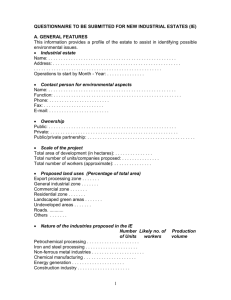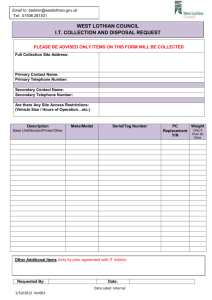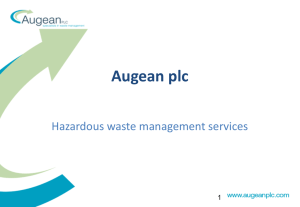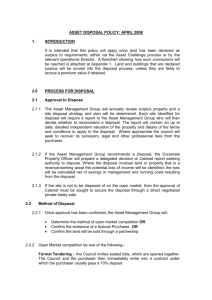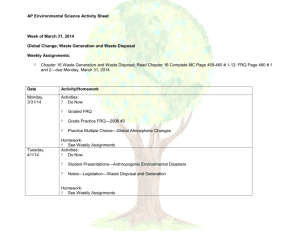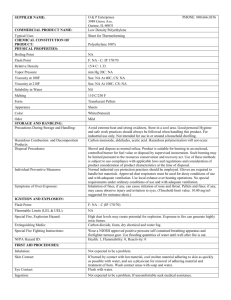Disposal of Land Assets Policy (Draft)
advertisement
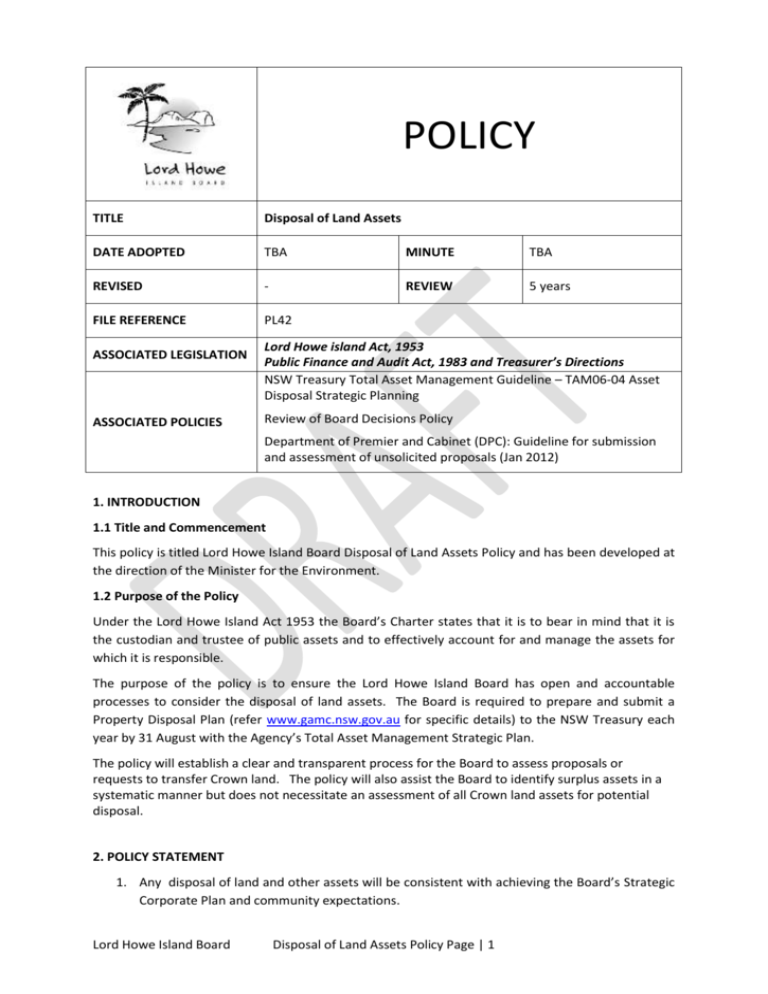
POLICY TITLE Disposal of Land Assets DATE ADOPTED TBA MINUTE TBA REVISED - REVIEW 5 years FILE REFERENCE PL42 ASSOCIATED LEGISLATION ASSOCIATED POLICIES Lord Howe island Act, 1953 Public Finance and Audit Act, 1983 and Treasurer’s Directions NSW Treasury Total Asset Management Guideline – TAM06-04 Asset Disposal Strategic Planning Review of Board Decisions Policy Department of Premier and Cabinet (DPC): Guideline for submission and assessment of unsolicited proposals (Jan 2012) 1. INTRODUCTION 1.1 Title and Commencement This policy is titled Lord Howe Island Board Disposal of Land Assets Policy and has been developed at the direction of the Minister for the Environment. 1.2 Purpose of the Policy Under the Lord Howe Island Act 1953 the Board’s Charter states that it is to bear in mind that it is the custodian and trustee of public assets and to effectively account for and manage the assets for which it is responsible. The purpose of the policy is to ensure the Lord Howe Island Board has open and accountable processes to consider the disposal of land assets. The Board is required to prepare and submit a Property Disposal Plan (refer www.gamc.nsw.gov.au for specific details) to the NSW Treasury each year by 31 August with the Agency’s Total Asset Management Strategic Plan. The policy will establish a clear and transparent process for the Board to assess proposals or requests to transfer Crown land. The policy will also assist the Board to identify surplus assets in a systematic manner but does not necessitate an assessment of all Crown land assets for potential disposal. 2. POLICY STATEMENT 1. Any disposal of land and other assets will be consistent with achieving the Board’s Strategic Corporate Plan and community expectations. Lord Howe Island Board Disposal of Land Assets Policy Page | 1 2. The process for the sale, disposal and acquisition of land assets will be fair, transparent and equitable to ensure that the Board obtains the best outcome on a fiscal and social basis. 3. All proposed sale and disposal of land will be advertised for a period of 28 days. 4. Commercial confidentiality will apply to negotiations for sale and disposal of land and other asset transactions unless the Board decides otherwise. 5. Disposal and transfer of land will be in accordance with the provisions of the Public Finance and Audit Act, 1983 and Treasurers Directions. 3. LAND VALUATION Crown land to be disposed under the Policy shall be valued by the Valuer General in accordance with the requirements of the Lord Howe Island Act, 1953. The transfer of all Crown Land shall only be at the value determined by the Valuer General in accordance with the requirements of the Lord Howe Island Act, 1953. The Board shall not recommend to the Minister to approve the transfer of Crown Land at a value less than that determined by the Valuer General except in accordance with Section 6 of the Policy. 4. FINANCIAL HARDSHIP Where a transferee of Crown land identifies financial hardship the Board may recommend to the Minister to request that the Treasurer approved the sale of the land at less than market value. Any request for the sale of the land at less than market value would be required that the Board identify strategies to make up the shortfall in revenue from the reduced sale price. Financial hardship is defined as a situation where a transferee is unable, reasonably, because of illness, unemployment or other reasonable cause, to discharge their financial obligations under the contract for transfer and the transferee reasonably expects to be able to discharge those obligations if payment arrangements were changed. 5. MINISTERIAL APPROVAL Crown Lands administered by the Board can be sold or transferred subject to compliance with the Board’s Land Asset Disposal Policy. On recommendation by the Board the disposal or transfer of such land can only occur with approval of the Minister. 6. APPLICATION OF POLICY 6.1 Land Classification The Board has adopted a formal process to classify of public land to improve the transparency and accountability in disposal of Crown land. All Crown lands administered by the Board have been classified as either “community” or “operational”. This Policy will apply to all Crown land Administered by the Board that has been classified as Operational land. 6.2 Community Land Classification as Community land reflects the importance of the land to the community because of its use or special features. Community land is generally defined as land intended for public access, community use or benefit or environmental protection. Community land is recognized as an important component of the environment, providing benefit for the community. Lord Howe Island Board Disposal of Land Assets Policy Page | 2 Community Land cannot be disposed of or consolidated into a Perpetual Lease. However Community Land can be included as part of a Special lease or Permissive Occupancy approved by the Minister. All land identified in the LHI Local Environment Plan 2010 under the following land use zones will be deemed as Community land: Zone 5 – Special Use Zone 6 - Recreation Zone 7 – Environmental Protection Zone 8 – Permanent Park Preserve Proposals to reclassify or rezone Community land to Operational land will be subject to a detailed analysis and public consultation process. The Board must obtain approval from the Minister to reclassify or rezone Community land. A detailed analysis of current and future community needs and benefits of Community land must be prepared as part of any proposal. 6.3 Operational Land Operational land has no special management restrictions other than those that may apply to any particular land zone or portion of land. Such restrictions are generally defined under the relevant planning and environmental legislation and other instruments, lease documents, Board policy and operational requirements. Operational land can be sold or transferred subject to compliance with the Board’s Land Asset Disposal Policy and approval by the Minister. All land identified in the LHI Local Environment Plan 2010 under the following land use zone will be deemed as Operational land: Zone 1 - Rural Zone 2 – Settlement Unzoned Land 7. DISPOSAL PLANNING AND CRITERIA 7.1 Land Asset Disposal Planning Land Asset Disposal planning involves two separate and distinct elements: the detailed assessment of land identified as Surplus by the Asset Strategy followed by an analysis of the physical Disposal of the assets. A Surplus asset is identified when it: Is not required for the delivery of services, either currently, or over the longer planning timeframe; or Becomes uneconomical to maintain and / or operate; or Is not suitable for service delivery. Disposal of the physical asset once it is identified as surplus depends on one or more of the following: Whether there are net disposal benefits, either in financial or other terms; Whether there are secondary service obligations associated with the asset which dictate its retention; and / or Lord Howe Island Board Disposal of Land Assets Policy Page | 3 Whether a disposal can be carried out without adverse impacts on the natural and physical environment. Assets identified as surplus to core service delivery requirements, may need to be retained due to heritage, open space or other social environmental considerations, which the Board may have as secondary service obligations. If an asset is not presently used, the likelihood of it being required within the foreseeable future should also be considered. Changing demographic trends or service demands may see a renewed call for the asset in its present or altered state. 7.2 Criteria The following criteria, as identified in the NSW Treasury Total Asset Management Guideline – TAM06-04 Asset Disposal Strategic Planning, will be utilised, but not limited, to assess whether the Board should retain or dispose of a land asset interest: Annual cost of maintenance Cost Benefit / Risk Analysis Current use / utilisation Cultural or historical significance Current state of the property Alternate future community use Area of land concerned Open Space Plan requirements How the property was acquired Covenants on the property Alternate future use Current Fair Value as determined by the Valuer General Relationship to service requirements and relevant strategic drivers Potential political consequences Level of community “ownership” Potential future use of adjacent properties Development potential To allow open and accountable assessment of the above matters assessment criteria will be implemented to allow cross comparison testing of issues and to allow the following decision matrix to be used. 7.3 Decision Matrix Based on the outcomes of the above process each land asset will be individually classified in terms of future use for the Board. High Strategic / Community Importance High Strategic / Community Importance Assessed Against Assessed Against High maintenance cost / High or Low usage Low maintenance cost / High usage OUTCOME: RE-DEVELOP OUTCOME: RETAIN Low Strategic / Community Importance Low Strategic / Community Importance Assessed Against Assessed Against High or Low maintenance cost / Low Usage Low maintenance costs / High usage OUTCOME: DISPOSAL OUTCOME: RETAIN PROPERTY IN THE SHORT TERM Where it is found that a land asset should be disposed of or in any other way removed from general public usage the process will at all times be governed by the requirements of the Public Finance and Audit Act 1983 and Treasurers Directions. Lord Howe Island Board Disposal of Land Assets Policy Page | 4 7.4 Details required in Property Disposal Plan A property disposal plan will be prepared following assessment that an identified portion of land satisfies the relevant assessment criteria. The following information is required to be provided for each property for ratification by the Government Asset Management Committee (GAMC) within NSW Treasury. Property Description Lot / DP Number Address Street Name Current Zoning Agricultural / Settlement, Environment protection, etc Current Use Details of usage (community space, specific purpose,etc) Site area Approximate area in square metres Site improvements Brief details of site improvements (if any) Tenure Vacant Crown Land, details of leasehold arrangements, etc Property Valuation Valuation figure and basis, date of valuation Heritage Status Details of heritage orders and / or heritage listings Ecological Status Threatened / protected species, protected environment / habitat (known or proposed Contaminated Soils / Buildings Brief details of contamination (if any) and remediation status Ministerial Comments Details of any known Ministerial comments / position re: land status and / or future uses. General Comments Any other pertinent information 8 RIGHT TO VARY OR REVOKE The LHIB reserves the right to vary or revoke this policy at any time in consultation with relevant parties. Lord Howe Island Board Disposal of Land Assets Policy Page | 5

